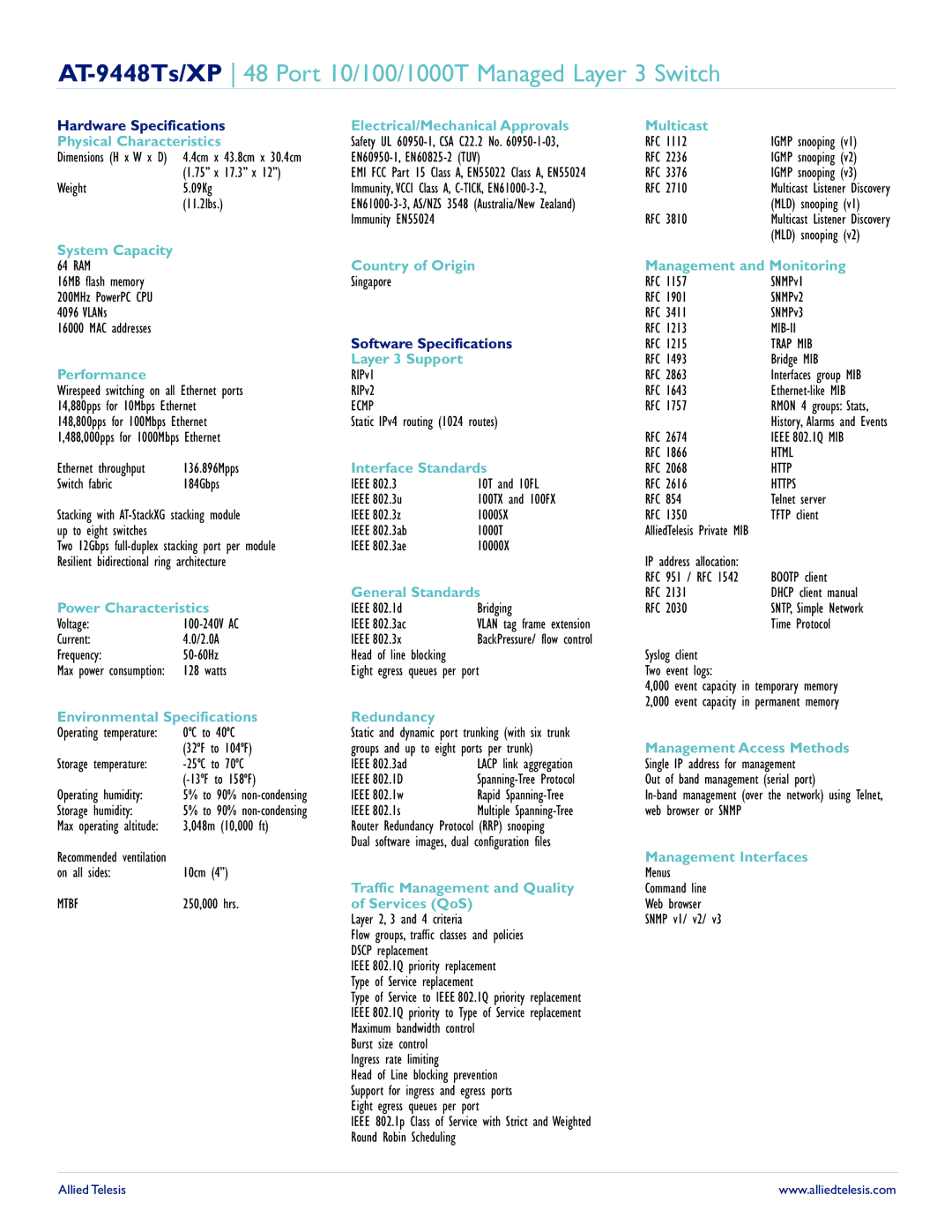
AT-9448Ts/XP 48 Port 10/100/1000T Managed Layer 3 Switch
Hardware Specifications
Physical Characteristics
Dimensions (H x W x D) | 4.4cm x 43.8cm x 30.4cm |
| (1.75” x 17.3” x 12”) |
Weight | 5.09Kg |
| (11.2lbs.) |
System Capacity |
|
64 RAM |
|
16MB flash memory |
|
200MHz PowerPC CPU |
|
4096 VLANs |
|
16000 MAC addresses |
|
Performance
Wirespeed switching on all Ethernet ports
14,880pps | for | 10Mbps Ethernet | |
148,800pps | for 100Mbps | Ethernet | |
1,488,000pps | for 1000Mbps Ethernet | ||
Ethernet throughput | 136.896Mpps | ||
Switch fabric |
| 184Gbps | |
Stacking with
Two 12Gbps
Resilient bidirectional ring | architecture | |||
Power Characteristics |
|
| ||
Voltage: |
| |||
Current: |
| 4.0/2.0A |
| |
Frequency: |
|
| ||
Max power consumption: | 128 watts | |||
Environmental Specifications | ||||
Operating temperature: | 0ºC to | 40ºC | ||
|
| (32ºF | to | 104ºF) |
Storage temperature: | to | 70ºC | ||
|
| |||
Operating humidity: | 5% to 90% | |||
Storage humidity: | 5% to 90% | |||
Max operating | altitude: | 3,048m | (10,000 ft) | |
Recommended | ventilation | 10cm | (4”) | |
on all sides: |
| |||
MTBF |
| 250,000 | hrs. | |
Electrical/Mechanical Approvals
Safety UL
EN60950-1, EN60825-2 (TUV)
EMI FCC Part 15 Class A, EN55022 Class A, EN55024
Immunity, VCCI Class A,
Immunity EN55024
Country of Origin
Singapore
Software Specifications
Layer 3 Support
RIPv1
RIPv2
ECMP
Static IPv4 routing (1024 routes)
Interface Standards
IEEE 802.3 | 10T and 10FL | |
IEEE 802.3u | 100TX and 100FX | |
IEEE 802.3z | 1000SX | |
IEEE 802.3ab | 1000T | |
IEEE 802.3ae | 10000X | |
General Standards | ||
IEEE 802.1d | Bridging | |
IEEE 802.3ac | VLAN tag frame extension | |
IEEE 802.3x | BackPressure/ flow control | |
Head | of line | blocking |
Eight | egress | queues per port |
Redundancy
Static and dynamic port trunking (with six trunk groups and up to eight ports per trunk)
IEEE 802.3ad | LACP link aggregation |
IEEE 802.1D | |
IEEE 802.1w | Rapid |
IEEE 802.1s | Multiple |
Router Redundancy Protocol (RRP) snooping | |
Dual software | images, dual configuration files |
Traffic Management and Quality of Services (QoS)
Layer 2, 3 and 4 criteria
Flow groups, traffic classes and policies DSCP replacement
IEEE 802.1Q priority replacement Type of Service replacement
Type of Service to IEEE 802.1Q priority replacement IEEE 802.1Q priority to Type of Service replacement Maximum bandwidth control
Burst size control Ingress rate limiting
Head of Line blocking prevention Support for ingress and egress ports Eight egress queues per port
IEEE 802.1p Class of Service with Strict and Weighted Round Robin Scheduling
Multicast |
|
|
| |
RFC | 1112 | IGMP | snooping | (v1) |
RFC | 2236 | IGMP | snooping | (v2) |
RFC | 3376 | IGMP | snooping | (v3) |
RFC | 2710 |
| Multicast Listener | Discovery | ||
|
|
| (MLD) | snooping (v1) | ||
RFC | 3810 |
| Multicast Listener | Discovery | ||
|
|
| (MLD) | snooping (v2) | ||
Management and Monitoring |
| |||||
RFC 1157 |
| SNMPv1 |
|
| ||
RFC 1901 |
| SNMPv2 |
|
| ||
RFC 3411 |
| SNMPv3 |
|
| ||
RFC | 1213 |
|
|
|
| |
RFC 1215 |
| TRAP MIB |
|
| ||
RFC 1493 |
| Bridge MIB |
|
| ||
RFC | 2863 |
| Interfaces group | MIB | ||
RFC | 1643 |
| MIB |
| ||
RFC | 1757 |
| RMON | 4 groups: Stats, | ||
|
|
| History, Alarms and Events | |||
RFC 2674 |
| IEEE 802.1Q MIB |
| |||
RFC 1866 |
| HTML |
|
|
| |
RFC 2068 |
| HTTP |
|
|
| |
RFC 2616 |
| HTTPS |
|
|
| |
RFC | 854 |
| Telnet | server |
|
|
RFC | 1350 |
| TFTP | client |
|
|
AlliedTelesis | Private MIB |
|
|
|
| |
IP address | allocation: |
|
|
|
| |
RFC | 951 / | RFC 1542 | BOOTP client |
|
| |
RFC | 2131 |
| DHCP | client | manual | |
RFC | 2030 |
| SNTP, Simple | Network | ||
|
|
| Time | Protocol |
| |
Syslog client |
|
|
|
| ||
Two | event | logs: |
|
|
|
|
4,000 event capacity in temporary memory |
| |||||
2,000 event capacity in | permanent memory |
| ||||
Management Access Methods Single IP address for management
Out of band management (serial port)
Management Interfaces
Menus
Command line
Web browser
SNMP v1/ v2/ v3
Allied Telesis | www.alliedtelesis.com |
